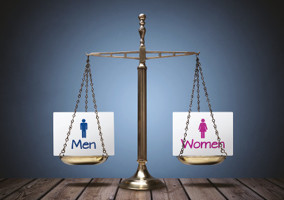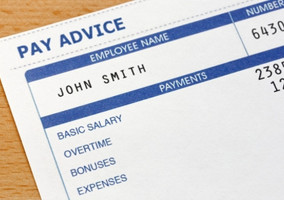In a sector dedicated to fairness and social justice, it seems obvious that employers should be moving towards truly inclusive workplaces.
All organisations with more than 250 employees have had to submit their annual gender pay gap data to the government by 4 April each year. The most recent published data relates to a snapshot from April 2021.
Now that we are five years into the mandatory gender pay gap reporting, it is a good time to look at how much progress charities have made.
Alas, in among the 100 large charity employers that Civil Society News has tracked over this period there has been little change collectively.
In 2017-18, the first year that reporting was mandated, the mean gender pay gap for our sample was 11.2% in favour of men. Five years on, it is 10.1%. This means that on average women earn 90p for every £1 earned by men.
On a positive note, the sector has consistently been better than the national average, which is estimated to be around 14%.
However, one-fifth of our sample have gaps above the national average, and the apparent lack of progress over five years should set alarm bells ringing.
By taking a closer look at individual charities it is clear that things may not be as stable as they appear. Some have made significant improvements, whereas others have seen their pay gap worsen. Naturally, the pandemic has also had an impact in different ways for different charities.
So, what is holding some charities back while others are steaming ahead?
Gaps that have widened
Changes to key personnel at senior level and gender spread through an organisation can have a knock-on effect on the gender pay gap.
ExtraCare Charitable Trust, which runs retirement villages, began the period with a mean gender pay gap of 10% in favour of men. It is now 25%, although the charity highlights its median pay gap, which excludes outliers at the top and bottom is small at 14%.
Chris Skelton, executive director corporate resources, says the reason for the gap lies with a high number of men in senior positions.
“Our gender pay gap is only significant in the highest pay quartile of the charity where there is a higher proportion of male employees than in the other quartiles,” he says.
Most (84%) of the charity’s employees are women.
Skelton adds: “The majority of our staff work in frontline roles such as care and catering, which are relatively lower paid roles that traditionally attract more women.
“We are confident that our gender pay gap does not reflect an equal pay issue nor is it related to us paying males and females differently while undertaking a similar role.”
Impact of Covid
Some charities suggest that the pandemic, particularly the furlough scheme, has made affected who is included in this analysis.
Barnardo’s witnessed a sudden widening of the gap in the fifth year of reporting. Having previously had a gap of been between 11% and 14%, this shot up to 18%, pushing the charity over the national average for the first time.
The charity says this is partly explained by the latest snapshot coinciding with its high use of the furlough scheme as fundraising activity was curtailed and shops were closed.
Rules meant Barnardo’s excluded 1,672 employees, largely from its retail arm, from its calculations and just 331 of them were men.
If Barnardo’s had included furloughed employees in its analysis, it believes the mean gap would have been in line with previous years.
Similarly, Cancer Research UK (CRUK) says the pandemic, and redundancies in its retail arm had a negative impact on the gender pay gap.
In April 2020, CRUK’s mean gender pay gap was 15%, but this increased to 19.7%.
Earlier this year, Michelle Mitchell, CEO of CRUK, said: “We aren’t where we want to be, and it is disappointing that we have not made progress in closing our gender pay gap. We are committed to driving change in line with the actions set out in our EDI (equality, diversity and inclusion) strategy and I’m confident that we have a solid plan in place to help us regain momentum in the years ahead.”
Elsewhere, the pandemic had the opposite effect on pay gaps.
The British Heart Foundation is an example of a charity where the gap shrunk due to employees being were furloughed.
In 2017-18, its pay gap was 7.7% and in the first two years of reporting this increased slightly, but has now fallen to 3.7%. But instead of celebrating the apparent improvement, BHF’s report cautions that a large proportion of its workforce were furloughed at the time of the snapshot.
Similarly, Historic Royal Palaces, where the gender pay gap has fallen to 3.5%, also caveats this year’s figure by highlighting the unusual circumstances around the pandemic.
From a very large gap to a large gap
Two charities that began with large gaps have made clear progress. Of course, it is easy to shrink the gap when starting out with an embarrassingly large pay disparity.
Indeed, Education Development Trust has seen its mean gender pay gap improve the most, with a gap of 30.4% five years ago shrinking to 12.1% in the latest report.
This has not come about by chance.
Last year the charity, which runs schools and carries out education research, set up a gender special interest group as part of an inclusion and diversity taskforce.
In the latest published gender pay report, Hilary Isham, global head of HR and property at Education Development Trust, says: “The inaugural meeting of the gender special interest group took place enabling meaningful and inclusive dialogue across the business on the key gender issues affecting staff.”
Next the charity plans to look at issues around “gendered behaviours and power dynamics, recruitment, pay and promotion”.
Elsewhere, the gender pay gap at MSI International has dropped by 10 percentage points to 35.5%, but the charity continues to have the largest pay gap of those in our sample.
MSI fairs slightly better using the median average, but still has a high gap of 30.3%. The charity says that the gap can be attributed to issues within the healthcare sector.
The charity has segmented its workforce into two groups: those providing NHS abortion services and those supporting international programmes from its London office.
This breakdown reveals that the gender pay gap for its London support workers is now marginally in favour of women at -0.6%, but the gap for those working on UK services is 26%.
“This is predominantly due to structural issues, which require longer-term change within institutions across the UK healthcare sector,” Sue Holland, global director of people and culture at MSI, writes in this year’s report.
“We are committed to being part of that change, and will continue to work with partners, professional bodies and government departments to address this challenge over the years ahead.”
Getting it right
Seven charities in the sample pay women on average slightly more than men.
One of these, Canal & River Trust has consistently paid women slightly more than men, with its mean gap of 2.6%.
However, the charity’s chief executive emphasises that there is more to do to ensure gender balance throughout the organisation.
The charity says that the balanced overall figure is largely down to women employed in the professional roles, who are more likely to feature in higher paid positions.
Richard Parry, Canal & River Trust chief executive, says: “We continue to focus on increasing the number of females in our organisation, particularly in those roles that tend to be more male dominated such as engineering and skilled trades.”
To address this, the charity plans to launch a women in leadership programme this year.
Work to do
The overall picture is not as bleak as it could be.
Last year there were fears that women would be disproportionately impacted by the pandemic, and thus far this does not seem to have come to pass. Although next year’s data release covering the post-furlough period may be more telling.
It is also clear that in some cases there are systemic challenges, which will take longer than five years to resolve. In other cases, the short-term impact of the pandemic has distorted this year’s figures.
There is, however, clearly still work to do.
How seriously a charity takes its commitment to closing the gap is an important indicator of the workplace culture, something potential employees will be looking out for.
While many charities do produce detailed reports explaining what the gap is and measures they are taking, too many produce short, perfunctory reports, which are unlikely to give prospective employees the confidence that the charity is living its values.
In a number of cases, charities have submitted this year’s data to the government portal, but which have not yet updated the narrative on their websites giving the context for any changes.
Furthermore, there was a tiny handful of charities that have failed to complete this year’s report. One described it to Civil Society News as an “oversight”. This is disappointing.
Charities should seize the opportunity to lead from the front on this kind of topic – not just because it is the right thing to do, but because studies have shown that more diverse groups make better decisions.
Finally, it’s important to look beyond gender. Some charities, to their credit have begun voluntarily reporting their race and disability gaps, and looking more holistically at how recruitment processes and workplaces can be fully inclusive.
Doing so is an important step in understanding barriers and making it possible to go about dismantling them, in order to create the conditions for a more effective workforce.
Related articles










